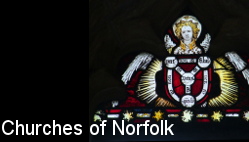
home I index I latest I glossary I introductions I e-mail I about this site
St Edmund, Swanton Novers
Follow these journeys as they happen at Last Of England Twitter.
St Edmund, Swanton Novers The village of Swanton Novers sits on the edge of the Melton Constable estate, but not even the coming of the railways that turned Melton Constable upside down in the 19th Century could shake Swanton Novers out of its sleepiness, and now the railways have gone. The narrow lane west from the village twists and dips, and, just before it turns into a sandy track, there is the church. It really feels as if you might fall off the edge of Norfolk if you went any further. In spring and summer the gently rolling landscape of fields and copses around is filled with the impatient calling of sheep, but on this day in November 2022 there was only the dripping from the trees after the incessant rain of the day so far, which felt like a mercy now that the rain had ceased. The churchyard is long and fairly narrow, and your first sight of the church from the north reveals its fairly complete 19th and 20th Century rebuilding. The aisle with its curious parapet and the chancel were completely rebuilt in 1881. Pevsner tells us that the architect was one Edwin Dolby of Abingdon, who doesn't appear to have done any other work of significance in Norfolk. The tower was substantially rebuilt as recently as 1961, for as an elderly parishioner told me a few years back on a visit, one good kick and it would have come down. She also told me that there was a discussion at the time about abandoning St Edmund, and building a new church up in the village, but this never happened. However, coming around to the south side, and with the caveat that Dolby also rebuilt the south porch, we get more of a sense of the medieval church. Pevsner was able to identify some details of 12th and 13th Century origin. You step into a church
which inevitably feels all of its 19th and 20th Century
restorations, but it is a pleasant, homely place that
despite its distance from its village is obviously well
cared for and loved. This homeliness extends to the font,
which is a charming 15th Century piece, the four symbols
of the Evangelists alternating with a curious symbol
which at first sight appears to be the nails of the
crucifixion set within a crown of thorns. However, these
nails make a W shape, and up in the chancel this symbol
is repeated on the canopy to the piscina but this time
within a chaplet of flowers. Incidentally, although this
cusped canopy is contemporary with the font, the piscina
below it dates from the 1881 restoration, and I think it
may have originally been part of an image niche. Simon Knott, November 2022 Follow these journeys as they happen at Last Of England Twitter. |
|
|||||||||||||||||||||||||||||||||||||||||||||||||||||||
home I index I latest I introductions I e-mail I about
this site I glossary
Norwich I ruined churches I desktop backgrounds I round tower churches
links I small
print I www.simonknott.co.uk I www.suffolkchurches.co.uk